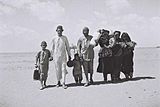- Menarsha synagogue attack
-
Jewish exodus from Arab countries 1947-1972 
Main articles Jewish exodus from Arab and Muslim countries
Immigrant camps · Maabarot
1948 Arab-Israeli War
Operation Magic Carpet (Yemen)
Operation Ezra and Nehemiah
1956 Expulsion of Egyptian JewsBackground Nazi relations with the Arab world · Farhud · Tripoli (1945) · Cairo (1945) · Immigration during and after World War II
Israeli Declaration of Independence · Suez Crisis · Algerian War · Six Day WarKey incidents Aleppo (Syria) · Aden (Yemen) · Oujda and Jerada (Morocco) · Tripoli (Libya) · Baghdad (Iraq) Arbitration WOJAC · JIMENA · Babylonian Jewry Heritage · JJAC · The David Project Resettlement Aliyah · Law of Return · Development towns · North African Jewry in France Related topics Jewish history · Jewish diaspora · History under Muslim rule
Mizrahi Jews · Sephardi Jews · Arab JewsThe Menarsha synagogue attack took place on August 5, 1949, in the Jewish quarter of Damascus, Syria.[1] The grenade attack resulted in 12 fatalities.
The attack
The situation for Syria's Jews deteriorated in the late 1930s, as unrest in Palestine resulted in increased hostility towards Zionism and Jews in general. With political and economic instability in the lead up to Syrian independence in 1946, anti-Western and Arab nationalist fervour took on an increasingly anti-Jewish tone.[2][3] After the establishment of the State of Israel in 1948, the Jews in Syria faced greater discrimination as the government enforced tighter restrictions on them.[4] During this period, Jews and their property became the target of attack.
On Friday night, August 5, 1949, several hand grenades were thrown into the Menarsha Synagogue in Damascus. 12 Jews, eight of them children,[5] were killed and about 30 others injured.[1] The attack was timed to coincide with the Lausanne Conference following the 1949 Armistice Agreement which was signed between Israel and Syria on July 20, 1949.[6] A simultaneous attack carried out at the Great Synagogue in Aleppo also resulted in several fatalities.[7]
Syrian President Husni al-Za'im sent his personal representative to visit the wounded and ordered to apprehend those responsible "without fail."[8] The police accredited the attack to an underground movement functioning under the name Arab Redemption Suicide Phalange[9] and arrested numerous suspects. On August 9, a seventeen-year-old Syrian veteran of the 1948 Arab–Israeli War confessed that he and two friends were behind the attack.[8] President al-Za'im ordered the execution of those accused, but a few days later the coup of Colonel Sami Hinnawi took place and al-Za'im himself was executed.[10] In 1950, those arrested in connection with the attack were acquitted for a cited “lack of evidence.”[11]
References
- ^ Cyrus Adler, Henrietta Szold. American Jewish year book, Volume 52, American Jewish Committee, 1951.
- ^ Walter P. Zenner. A global community: the Jews from Aleppo, Syria, Wayne State University Press, 2000. pg. 82. ISBN: 0814327915.
- ^ Michael R. Fischbach. Jewish property claims against Arab countries, Columbia University Press, 2008. pg. 30. ISBN: 0231135386.
- ^ James A. Paul. Human rights in Syria, Middle East Watch. pg. 92.
- ^ Moshe Gat. The Jewish exodus from Iraq, 1948-1951, Routledge, 1997. pg. 188. ISBN: 071464689X.
- ^ Yazīd Ṣāyigh. Armed struggle and the search for state: the Palestinian national movement, 1949-1993, Oxford University Press US, 1997. pg. 72. ISBN: 0198292651.
- ^ Itamar Leṿin. d doors: the seizure of Jewish property in Arab countries, Greenwood Publishing Group, 2001. pg. 175. ISBN: 0275971341.
- ^ a b Joseph B. Schechtman. On wings of eagles: the plight, exodus, and homecoming of oriental Jewry, T. Yoseloff, 1961. pg. 163.
- ^ Sami M. Moubayed. Damascus between democracy and dictatorship, University Press of America, 2007. pg. 70-71. ISBN: 0761817441.
- ^ G. N. Giladi. Discord in Zion: conflict between Ashkenazi & Sephardi Jews in Israel Scorpion Publishing, 1990. pg. 89. ISBN: 090590687X.
- ^ The Jewish Agency's digest of press and events, Volume 3, Jewish Agency for Israel, 1950. pg. 1,080. [University of California, February 1, 2010.]
Anti-Jewish attacks in Arab countries during the 1948 Arab-Israeli War and its aftermath 1947 Aleppo pogrom (Syria) • Aden pogrom (Aden) • Manama pogrom (Bahrain)1948 Oujda and Jerada pogrom (Morocco) • Cairo June bombing (Egypt) • Cairo July bombing (Egypt) • 1948 Tripoli pogrom (Libya)1949 Menarsha synagogue attack (Syria) • Cairo bombing (Egypt)Categories:- Terrorism in Syria
- Terrorist incidents in the 1940s
- Terrorist attacks attributed to Palestinian militant groups
- 20th-century attacks on synagogues and Jewish communal organizations
- Jewish Syrian history
- 1948 Arab–Israeli War
Wikimedia Foundation. 2010.
